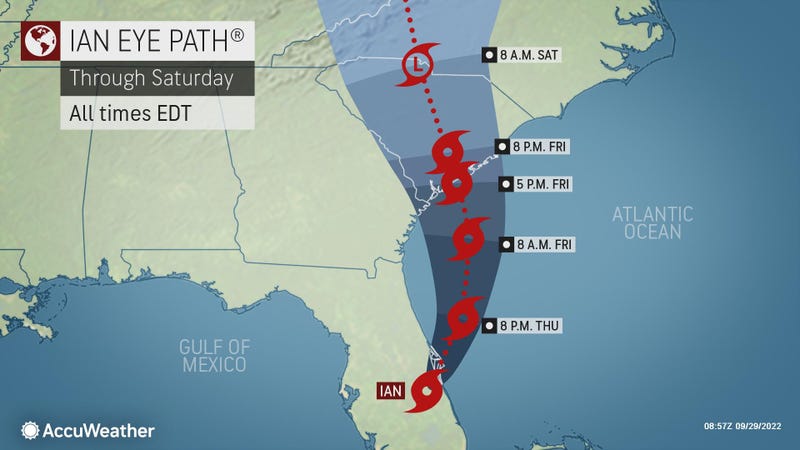
(ACCUWEATHER) After slamming into Florida’s west coast Wednesday afternoon, Hurricane Ian began to lose wind intensity as it trudged inland. By 5 a.m. Thursday the hurricane was downgraded to a Tropical Storm, packing maximum sustained winds of 65 mph.
For wind gusts, the highest reported thus far was a 126 mph gust by a NOAA station in Captiva/Redfish Pass. Other top gusts were reported at Cape Coral Fire Department (125 mph), Punta Gorda Airport (124 mph), and Cape Coral EOC (122 mph). Near Port Charlotte, a private weather station reported a sustained wind of 115 mph as Ian made landfall over the mainland.
North Central Florida will experience tropical storm force winds through Thursday, along with bands of heavy rain as the center of Ian moved into Orlando and into the Atlantic south of Daytona Beach. Surge and heavy rainfall have elevated flooding concerns along the St. John's River, and areas of northeastern Florida as Ian moves offshore.
Heavy rain from Ian has fallen in many parts of Florida, including Orlando. Between 11 p.m. EDT Wednesday and 2 a.m. Thursday, 3.70 inches of rain fell. An additional 2.63 inches fell between 2 a.m. EDT and 3 a.m. Thursday. Since the rain began, an incredible 12.24 inches has been recorded Orlando International Airport, and the rain is still falling. The rain has been falling in sheets, with a peak wind gust of 60 mph recorded at the airport.
Power outages brought on by Hurricane Ian’s landfall in Florida have topped 2.4 million as of 3 a.m. THursday morning, according to PowerOutage.US. Multiple counties were over 90% without service. DeSoto County’s power has been nearly completely wiped out, as 99.5% of the population was without power. Charlotte County had a 98% outage with over 125,000 customers affected, while Lee County (93.5% outages) had over 440,000 customers cut off. Hardee County’s power was also 91% cut off as of Wednesday evening.
Destructive flooding submerged places like Fort Myers Beach and Naples, leaving behind scenes of chaos. Meanwhile, fierce winds cut power to more than 1 million customers in the Sunshine State as excessive rain fell.
Florida Gov. Ron DeSantis updated residents on devastation Hurricane Ian has so far wrought across his state, noting that Ian will likely go down as one of the largest storms to ever hit the Sunshine State. "It's going to rank as one of the top five hurricanes to ever hit the Florida Peninsula," DeSantis said of the storm, comparing Ian to the likes of 1992's Hurricane Andrew and 2018's Hurricane Michael. "The fact is, there's going to be damage throughout the entire state."
DeSantis also took time to thank the 26 states that have sent resources in support of Ian recovery, such as Tennessee, Virginia, Montana, New York and Colorado. The governor also pointed to the Florida Disaster Fund as a way to help the recovery for those in need.
The Florida Disaster Fund will distribute donations to service organizations that will aid individuals within disaster-stricken communities. Donations can be made online through the Volunteer Florida Foundation, with checks also acceptable form of payment.
Federal Emergency Management Agency (FEMA) Administrator Deanne Criswell said that FEMA has established a search and rescue coordination group in Miami that includes Urban Search and Rescue teams, Coast Guard, Department of Defense, Department of the Interior and local Florida rescue teams. Criswell briefed President Joe Biden and Florida mayors Tuesday on federal response efforts to Hurricane Ian.
With search and rescues ready to be made by sea, air and land, FEMA has also positioned supplies and personnel to strategic locations in Georgia, Florida and Alabama to “get help where it needs to be as soon as possible.” The organization has 3.7 million meals and 3.5 million liters of water staged in Alabama, ready to be distributed to storm-stricken areas.
Beyond what Hurricane Ian does as it pummels Florida, the storm will continue to spread flooding rainfall, coastal impacts and the potential for damaging winds northward as yet another landfall in the Southeast was becoming increasingly likely.
States of emergency have been declared in Georgia, Virginia and the Carolinas in advance of Ian's arrival, and tropical storm watches and warnings as well as storm surge warnings have been posted.
A quick loss in wind intensity is continued Wednesday night into Thursday as Ian slows down and moves inland over Florida. Despite the fact that Ian will be downgraded to a Tropical Storm, the storm’s impacts will worsen and expand in reach across the Southeast. According to AccuWeather Senior Meteorologist Courtney Travis, "No matter how quickly Ian loses wind intensity after moving inland, tropical rainfall is forecast to impact more than half a dozen states into Saturday."
